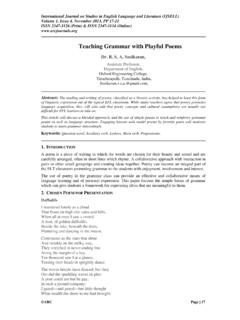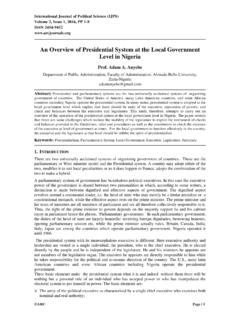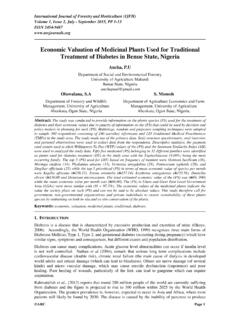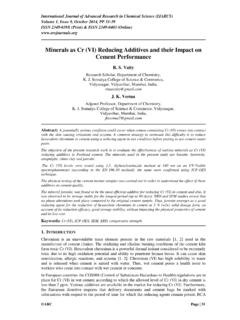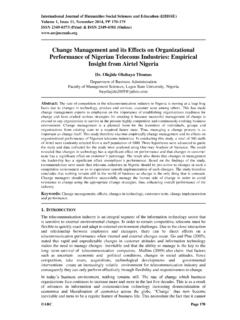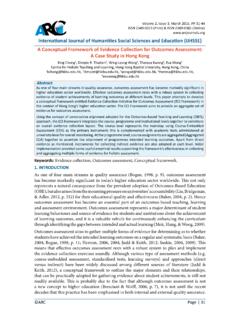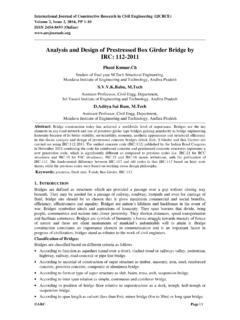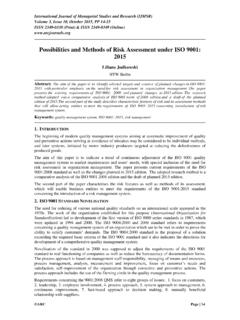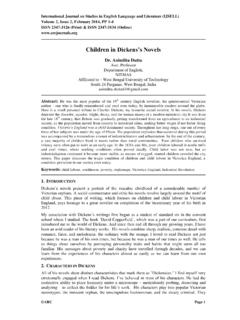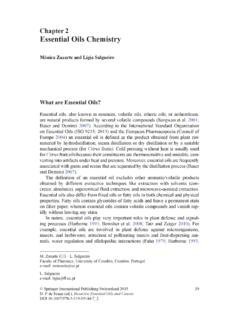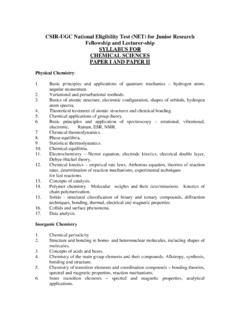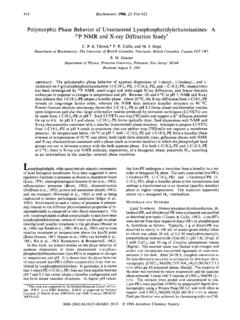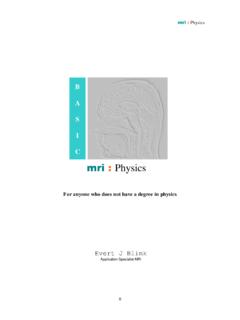Transcription of General Techniques Involved in Phytochemical …
1 International Journal of Advanced Research in Chemical Science (IJARCS) Volume 2, Issue 4, April 2015, PP 25-32 ISSN 2349-039X (Print) & ISSN 2349-0403 (Online) ARC Page | 25 General Techniques Involved in Phytochemical Analysis Banu Assistant Professor, Department of Chemistry, Selvam College of Technology, Namakkal Dr. Assistant Professor, Department of Chemistry, Holy cross College, Tiruchirappalli Abstract: Plants are recognized in the pharmaceutical industry for their broad structural diversity as well as their wide range of pharmacological activities. The biologically active compounds present in plants are called phytochemicals.
2 These phytochemicals are derived from various parts of plants such as leaves, flowers, seeds, barks, roots and pulps. These phytochemicals are used as sources of direct medicinal agents. They serve as a raw material base for elaboration of more complex semi-synthetic chemical compounds. This paper mainly deals with the collection of plants, the extraction of active compounds from the various parts of plants, qualitative and quantitative analysis of the phytochemicals. Keywords: Phytochemicals, Decoction, Infusion, HPLC, HPTLC, OPLC, NMR, X-Ray crystallography. 1. INTRODUCTION Phytochemicals are the chemicals that present naturally in plants. Now- a-days these phytochemicals become more popular due to their countless medicinal uses.
3 Phytochemicals play a vital role against number of diseases such as asthma, arthritis, cancer etc. unlike pharmaceutical chemicals these phytochemicals do not have any side effects. Since the phytochemicals cure diseases without causing any harm to human beings these can also be considered as man- friendly medicines . This paper mainly deals with collection, extraction, qualitative and quantitative analysis of phytochemicals. 2. STEPS Involved IN PLANT COLLECTION Collection of Plants Plants under consideration may be collected either from wild forests or from herbariums. When plants are collected from wild, there is a risk that they have been incorrectly identified. The major advantage of wildlife plants is that they will not contain any pesticides.
4 After the plants are collected from wild or from herbarium they have to be processed for cleaning in order to prevent the deterioration of phytochemicals present in plants. Cleaning of Plants After plants collection they have to be cleaned properly. The cleaning process may involve the following steps. Cleaning, washing, peeling or stripping leaves from stems. Cleaning has to be done by hands in order to get better results. Drying The main purpose of drying is to remove the water content from plants so that the palnts can be stored. Plants have to be dried immediately as soon as the plants collection or this will lead to spoilage of plant materials. The drying consists of two methods. Drying can be done either by natural process or by artificial process.
5 Natural Process Natural process includes sun- drying. Sometimes plants are placed on drying frames or on stands, to be air-dried in barns or sheds. But this may take few weeks for complete drying. The time depends on temperature and humidity. Banu & Dr. International Journal of Advanced Research in Chemical Science (IJARCS) Page 26 Artificial Drying Artificial drying can be done with the help of artificial driers. This process will reduce the drying time to several hours or minutes. The common method that is followed in drying medicinal plants is warm-air drying. In this process plants are placed in the plates of drier on which warm air is blown. This method is mainly applicable to fragile flower and leaves and this requires large number of workers since loading and unloading of plants has to be done manually.
6 Powdering After complete drying of plants they have to be powdered well for further analysis 3. METHODS OF EXTRACTION Plant Tissue Homogenization Plant tissue homogenization in solvent has been widely used by researchers. Dried or wet, fresh plant parts are grinded in a blender to fine particles, put in a certain quantity of solvent and shaken vigorously for 5 - 10 min or left for 24 h after which the extract is filtered. The filtrate then may be dried under reduced pressure and re-dissolved in the solvent to determine the concentration. Some researchers however centrifuged the filtrate for clarification of the extract [1]. Serial Exhaustive Extraction It is another common method of extraction which involves successive extraction with solvents of increasing polarity from a non polar (hexane) to a more polar solvent (methanol) to ensure that a wide polarity range of compounds could be extracted.
7 Some researchers employ soxhlet extraction of dried plant material using organic solvent. This method cannot be used for thermolabile compounds as prolonged heating may lead to degradation of compounds [1]. Soxhlet Extraction Soxhlet extraction is only required where the desired compound has a limited solubility in a solvent, and the impurity is insoluble in that solvent. If the desired compound has a high solubility in a solvent then a simple filtration can be used to separate the compound from the insoluble substance. The advantage of this system is that instead of many portions of warm solvent being passed through the sample, just one batch of solvent is recycled. This method cannot be used for thermolabile compounds as prolonged heating may lead to degradation of compounds [2].
8 Maceration In maceration (for fluid extract), whole or coarsely powdered plant- drug is kept in contact with the solvent in a stoppered container for a defined period with frequent agitation until soluble matter is dissolved. This method is best suitable for use in case of the thermolabile drugs [3]. Decoction This method is used for the extraction of the water soluble and heat stable constituents from crude drug by boiling it in water for 15 minutes, cooling, straining and passing sufficient cold water through the drug to produce the required volume [4]. Infusion It is a dilute solution of the readily soluble components of the crude drugs. Fresh infusions are prepared by macerating the solids for a short period of time with either cold or boiling water [4].
9 Digestion This is a kind of maceration in which gentle heat is applied during the maceration extraction process. It is used when moderately elevated temperature is not objectionable and the solvent efficiency of the menstrum is increased thereby [4]. Percolation This is the procedure used most frequently to extract active ingredients in the preparation of tinctures and fluid extracts. A percolator (a narrow, cone-shaped vessel open at both ends) is generally used. The solid ingredients are moistened with an appropriate amount of the specified menstrum and allowed to stand for approximately 4 h in a well closed container, after which the General Techniques Involved in Phytochemical Analysis International Journal of Advanced Research in Chemical Science (IJARCS) Page 27 mass is packed and the top of the percolator is closed.
10 Additional menstrum is added to form a shallow layer above the mass, and the mixture is allowed to macerate in the closed percolator for 24 h. The outlet of the percolator then is opened and the liquid contained therein is allowed to drip slowly. Additional menstrum is added as required, until the percolate measures about three- quarters of the required volume of the finished product. The marc is then pressed and the expressed liquid is added to the percolate. Sufficient menstrum is added to produce the required volume, and the mixed liquid is clarified by filtration or by standing followed by decanting [5]. Sonication The procedure involves the use of ultrasound with frequencies ranging from 20 kHz to 2000 kHz; this increases the permeability of cell walls and produces cavitation.
